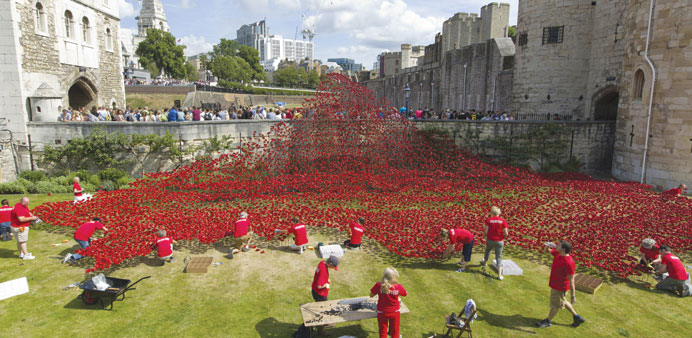AFP/London
An altar cloth embroidered by 138 wounded World War I soldiers was to take its place again yesterday at Saint Paul’s Cathedral in London to mark the centenary of the conflict’s outbreak.
The frontal which has not been on display here for seven decades was embroidered by severely wounded or shell-shocked men from Britain, Australia, Canada and South Africa in memory of their fallen comrades in arms.
“Of the many forms of rehabilitation, embroidery was seen as a good way of greatly helping to reduce the effects of shell shock, owing to its intricacy and need for concentration and a steady hand,” the cathedral said on its website.
The intricate needlework was commissioned for the national service of thanksgiving in July 1919 marking the end of the war the year before.
On Sunday, the Bishop of London Richard Chartres was to preside over a Eucharist service at which the altar frontal will be used for the first time since World War II.
Ida Missing, daughter of Driver Percy Cooney, and Ronald Barnes, son of Private Herbert Barnes, two of the men who contributed to the embroidery, were due to attend the service.
Also due to attend were the grandchildren of Lance Corporal James Ernest Muth of the Royal Regiment of Canada, who were flying in from Ontario for the occasion.
Muth’s grandson, also a lance corporal in the Canadian Army, was to read a lesson.
On Monday, special prayers were to be said at evensong to mark the centenary of the war’s outbreak.
The cathedral was to remain open afterwards for quiet prayer and reflection and to allow people to visit the new altar frontal display in the north transept, commemorating the lives of the hospitalised men who made it.
The display will run throughout the centenary period, until November 11, 2018.
Britain declared war on Germany on August 4, 1914. More than 1.1mn troops from the British empire lost their lives in the four-year conflict.
The frontal shows intricate floral and bird designs, which the chalice of the Eucharist and the palm branches of martyrdom.
It was specially commissioned for the 1919 national service of thanksgiving, attended by king George V and queen Mary.
Wounded servicemen recovering in hospitals contributed small sections, which were then collected at the Royal School of Needlework in London to be stitched together.
The Reverend Canon Michael Hampel, the precentor of St. Paul’s Cathedral, said traumatised soldiers had been taught stitching as early as the Crimean War (1853-1856), to bring a calming effect.
“Creativity lifts your mind out of the here and now, and allows you to focus on other things rather than just the physical effects of war, and also the mental effects of war,” he told AFP.
“The fact that the men knew they were also creating something which would act as a memorial to their comrades who hadn’t returned from the front was also a very important focus for them.”
During World War II, Nazi bombs destroyed the east end of the cathedral, including the high altar, but the frontal survived.
In the restoration, a new high altar was made but with different dimensions and the frontal was no longer displayed.
But the cloth is being used again “not as a one-off, but as the centrepiece and focal point of the cathedral’s commemorations of the centenary of the war,” says St. Paul’s.
It has been restored by St Paul’s, while members of cathedral staff, plus volunteers from the Western Front Association, have pieced together information about the men from across the globe who created it.
Following an appeal, photographs, documents, family members and stories from around the world came in, telling the tale of the 138 men and what became of them.
The new display in the Anglican cathedral’s north transept preserves the memory of those who worked on the embroidery.
The altar frontal also prompts visitors to think of the people who survived the front line, said Hampel.
“Quite often we think about the appalling loss of life, but not so much about the people who came back and who were suffering the effects of what they had both done and experienced,” he said.

Volunteers install porcelain poppies as part of the art installation ‘Blood Swept Lands and Seas of Red’ by ceramic artist Paul Cummins and theatre st
